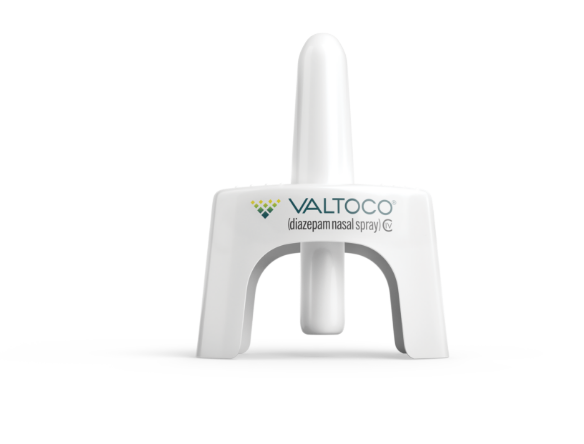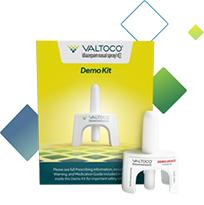VALTOCO features 5-dose packaging to provide more support. Find out more
VALTOCO is used to treat
episodes of frequent seizures.
A resilient college graduate who carries VALTOCO
A resilient college graduate who carries VALTOCO

VALTOCO is used to treat
episodes of frequent seizures.
Esteban, a resilient college graduate who carries VALTOCO

Pay as little as $20* for your VALTOCO prescription with the Copay Card.

VALTOCO is the only prescription nasal spray that works fast and lasts all day to stop episodes of frequent seizures for people ages 2 and up.†, ‡
†Individual results may vary.
‡People with epilepsy used a single dose of VALTOCO for 87% of treated seizure episodes within a 24-hour period.
The safety of VALTOCO has been well established. The most common local side effects were mild to moderate and included nose discomfort (5%), altered taste (2%), nosebleeds (2%), and runny nose (1%).
FDA approved for ages 2 years and older, VALTOCO will stay by your side through childhood, adolescence, and into adulthood.
An outgoing traveler and full-time employee who found confidence to venture out with VALTOCO



Request a free VALTOCO Demo Kit that includes a training device, quick-start guide, medication guide, and more.

An epilepsy advocate with a love for travel who keeps VALTOCO nearby for peace of mind
“My parents knew something was very wrong when, on that morning, they were unable to wake me for school. They quickly gathered me and my brother and rushed to a local children’s hospital. After a ton of tests—MRIs, CT scans, blood work, EEGs, and various other prodding and probing—the neurologist diagnosed me with epilepsy.
“As I got older, the time it would take for me to recover from my seizures gradually got longer and longer, while the frequency lessened. I couldn’t just wake up a few hours after my seizures like I used to and be okay. Instead, it took two or three days to fully recover from each seizure. And that’s how things progressed into my teen years.”
“Through EEGs, MRIs, and about a dozen other tests, they were able to quickly determine that my seizures were coming from my frontal lobe. If uncontrolled, my seizures would affect those functions associated with the frontal lobe, such as reasoning, planning, and long-term memory.
“This scared the life out of me. I was on a daily seizure medication, sure, but I still struggled with seizure control. My mother had diazepam rectal gel to use as an immediate-use seizure medication in case of episodes of frequent seizures, but who wants their mom using that on them? It was not ideal. I yearned to be independent and manage things on my own.”
“I remember when I was about 19 years old, I wanted to take a trip to South Africa by myself. I was tired of epilepsy controlling where I went and who I went with. Having a Seizure Action Plan has allowed me a little peace of mind and freedom to travel solo.
“But there was still one part I had to figure out—my immediate-use seizure medication. So a few years ago, I was talking with my epileptologist, who suggested VALTOCO. The same medication, but no more rectal administration? Yes, please.
“Now I have VALTOCO on hand with me everywhere I go. It gives me peace of mind because it’s less embarrassing to use and it’s easy to train others around me how to use it. I’m really pleased at how quickly VALTOCO works to stop my seizure clusters.*
“There is something empowering about finding an immediate-use seizure medication that works for you, and I think for me, this was a sign that something could be done about epilepsy, that we didn’t have to let it rule over our lives anymore.”
*Individual results may vary.
CT = computed tomography; EEG = electroencephalogram; MRI = magnetic resonance imaging.

A caring pharmacy technician and camp counselor who carries VALTOCO to stop her episodes of frequent seizures*
*Individual results may vary.
I’m a pharmacy technician and volunteer with support groups and various camps for kids from all avenues of life. I always did my best to be there for them, but I never dreamed that one day, I’d be the one that needed help when I was diagnosed with epilepsy and episodes of frequent seizures.”
“I was working as a social worker and youth specialist at a residential rehab for troubled teenagers. [After experiencing a head injury,] I began having strange feelings I couldn’t explain, kind of like feeling spaced out. These feelings became more intense and frequent over the next couple months.
“I was taking a group of teens from the children’s home to see a movie. That weird feeling hit me in the theater, so I got up for a drink of water and the next thing I knew I was on the floor having my first grand mal seizure. I was rushed to the ER and given anti-seizure drugs, along with a litany of tests, including an EEG, EKG, and CT scans.
“When the test results came back, they suspected I’d had a grand mal seizure, and I was formally diagnosed with epilepsy. Those strange feelings I’d been having were called auras that, for many patients, precede the actual seizure.”
“Adjusting to life with epilepsy was tough. At the time, there weren’t any immediate-use seizure medications for episodes of frequent seizures available to help in an emergency that could be promptly administered by someone nearby.
“Because my seizures were unpredictable, I never returned to work at the children’s home because it would put them at risk. Life went on and I continued having seizures: on the bus, in the grocery store, at restaurants, or just walking down the street. The worst part was that I never knew when or where my seizures would occur, if they would be small or large, or even worse, become a cluster.
“It was hard not to feel that epilepsy was trying to limit my life.”
“Around this same time, though, I became aware of VALTOCO. I liked that it was an easy-to-use immediate-use seizure medication. It’s also less awkward or embarrassing because I don’t have to rely on someone else to administer it rectally. I liked that I could carry it around with me in my backpack or coat pocket, and that for most people, one dose usually works.
“So I did my research to learn more and asked my nurse practitioner and neurologist what they thought about it. They agreed it would be a good option for me.
“While most of my seizures are nocturnal, I’m very aware of the things that tend to trigger them, like allergies, stress, lack of sleep, low blood sugar, or just being worn down. My nurse practitioner told me when I have those signs, I can go ahead and self-administer VALTOCO. I love that I have an immediate-use seizure medication I can use quickly, and I don’t have to plan my day around administering it. Because of that, I don’t feel like I’m missing out on life as much as I used to.”
CT = computed tomography; EEG = electroencephalogram; EKG = electrocardiogram.

An outgoing traveler and full-time employee who found confidence to venture out with VALTOCO
“Now fast-forward to the tradition of documenting the end of childhood and the beginning of adulthood with high school senior pictures. The next thing I knew, I felt myself bobbing up and down as if I were on a raft in the middle of a lake. I opened my eyes and saw flashing red and white lights refracting through the rain pelting the windows of the ambulance. The paramedic reassured me that my family was following close behind us and that we were on our way to the nearest hospital.
“Before I was discharged from the hospital, a neurologist officially diagnosed me with a seizure disorder.”
“My neurologist and I never considered an immediate-use seizure medication for me because my seizures have never lasted much longer than three minutes, but I still felt like there was more I could do. I decided I needed to advocate for myself.
“We talked about VALTOCO. We decided it was worth a shot, and we worked together to make it a part of my Seizure Action Plan. In my desk, I have a neon box I keep as an emergency kit for when I have a seizure. Inside, I keep VALTOCO and a list of emergency contacts. Everyone in my office knows where it is and how to use it as part of my Seizure Action Plan.
“It feels great to be able to go out with confidence and know there is something I can do if I feel an aura coming on or experience a seizure.
“For years, I let epilepsy rob me of the spotlight. But since I’ve always had a flair for the dramatic, I’ve taken it back. My hope for the future moving forward is that people never let anything, especially epilepsy, rain on their parade. So, I encourage you—be bold. Take the stage. Your audience awaits you.”

A career mom with epilepsy